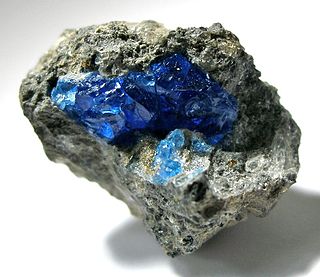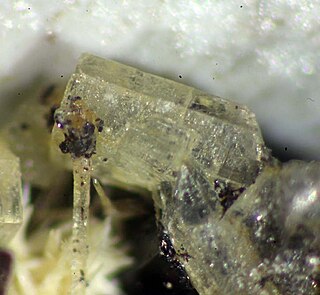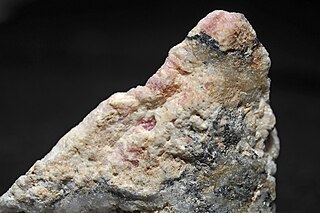 W
WAfghanite, (Na,K)22Ca10[Si24Al24O96](SO4)6Cl6, is a hydrous sodium, calcium, potassium, sulfate, chloride, carbonate alumino-silicate mineral. Afghanite is a feldspathoid of the cancrinite group and typically occurs with sodalite group minerals. It forms blue to colorless, typically massive crystals in the trigonal crystal system. The lowering of the symmetry from typical (for cancrinite group) hexagonal one is due to ordering of Si and Al. It has a Mohs hardness of 5.5 to 6 and a specific gravity of 2.55 to 2.65. It has refractive index values of nω=1.523 and nε=1.529. It has one direction of perfect cleavage and exhibits conchoidal fracture. It fluoresces a bright orange.
 W
WHauyne, haüyne, hauynite or haüynite is a tectosilicate sulfate mineral with endmember formula Na3Ca(Si3Al3)O12(SO4). As much as 5 wt % K2O may be present, and also H2O and Cl. It is a feldspathoid and a member of the sodalite group. Hauyne was first described in 1807 from samples discovered in Vesuvian lavas in Monte Somma, Italy, and was named in 1807 by Brunn-Neergard for the French crystallographer René Just Haüy (1743–1822). It is sometimes used as a gemstone.
 W
WKalsilite (KAlSiO4) is a vitreous white to grey feldspathoidal mineral that is found in some potassium-rich lavas, such as from Chamengo Crater in Uganda. It has a relative hardness of 5.5.
 W
WLazurite is a tectosilicate mineral with sulfate, sulfur and chloride with formula (Na,Ca)8[(S,Cl,SO4,OH)2|(Al6Si6O24)]. It is a feldspathoid and a member of the sodalite group. Lazurite crystallizes in the isometric system although well‐formed crystals are rare. It is usually massive and forms the bulk of the gemstone lapis lazuli.
 W
WLeucite is a rock-forming mineral of the feldspathoid group, silica-undersaturated and composed of potassium and aluminium tectosilicate KAlSi2O6. Crystals have the form of cubic icositetrahedra but, as first observed by Sir David Brewster in 1821, they are not optically isotropic, and are therefore pseudo-cubic. Goniometric measurements made by Gerhard vom Rath in 1873 led him to refer the crystals to the tetragonal system. Optical investigations have since proved the crystals to be still more complex in character, and to consist of several orthorhombic or monoclinic individuals, which are optically biaxial and repeatedly twinned, giving rise to twin-lamellae and to striations on the faces. When the crystals are raised to a temperature of about 500 °C they become optically isotropic and the twin-lamellae and striations disappear, although they reappear when the crystals are cooled again. This pseudo-cubic character of leucite is very similar to that of the mineral boracite.
 W
WNepheline, also called nephelite (from Greek: νεφέλη, "cloud"), is a rock forming mineral in the feldspathoid group: a silica-undersaturated aluminosilicate, Na3KAl4Si4O16, that occurs in intrusive and volcanic rocks with low silica, and in their associated pegmatites. It is used in glass and ceramic manufacturing and other industries, and has been investigated as an ore of aluminium.
 W
WNosean, also known as noselite, is a mineral of the feldspathoid group with formula: Na8Al6Si6O24(SO4). H2O. It forms isometric crystals of variable color: white, grey, blue, green, to brown. It has a Mohs hardness of 5.5 to 6 and a specific gravity of 2.3 to 2.4. It is fluorescent. It is found in low-silica igneous rocks. There is a solid solution between nosean and hauyne, which contains calcium.
 W
WSodalite is a rich royal blue tectosilicate mineral with the formula Na8(Al6Si6O24)Cl2, widely used as an ornamental gemstone. Although massive sodalite samples are opaque, crystals are usually transparent to translucent. Sodalite is a member of the sodalite group with hauyne, nosean, lazurite and tugtupite.
 W
WTugtupite is a beryllium aluminium tectosilicate. It also contains sodium and chlorine and has the formula Na4AlBeSi4O12Cl. Tugtupite is a member of the silica-deficient feldspathoid mineral group. It occurs in high alkali intrusive igneous rocks.